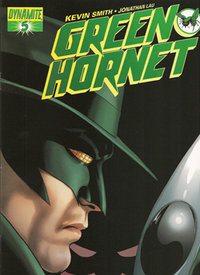
The Green Hornet
Heroes who operate on both sides of the law have long been popular in comics and crime fiction. Such a character is the masked mystery man called the Green Hornet, a crime fighter who gamboled with gangsters in order to sting them for apprehension.
The Green Hornet and Kato first appeared in a 1936 radio drama produced by George W. Trendle, whose previous program, The Lone Ranger, was a tremendous (and perennial) success. Revisiting The Lone Ranger's proven formula--an enigmatic masked hero accompanied by a loyal ethnic partner (in the Ranger's case, his Native American companion, Tonto)--The Green Hornet took the concept one step further, linking the two series into a generational saga. Historians acknowledge radio scriptwriter Fran Striker as the principal creator of the Green Hornet.
The Green Hornet is actually Britt Reid, whose father Dan is the Lone Ranger's nephew. The Ranger's penchant for silver bullets (and even his horse's name) was derived from the family's silver mine, which dispassionate Britt inherits and begins to squander as a playboy. He picks up a manservant on an excursion to Japan, after rescuing a young man named Kato from peril; Kato returns the favor by dedicating his life to his redeemer. Back in the States, Reid assumes the family business--The Daily Sentinel newspaper, which targets organized crime--and rises beyond his flippancy as he matures into its publisher. On a nighttime jaunt to collect evidence against mobsters for a Sentinel exposť, Reid and chauffeur Kato are spotted at the scene of the crime in their unique sedan--the Black Beauty--and the car is added to the police's most-wanted list. Reid, abetted by his executive assistant Lenore Case and a handful of confidantes within the police department, preserves his underworld branding by adopting the masked identity of the Green Hornet, and along with Kato, an accomplished martial artist, begins a battle against crime by pretending to be on its side.
The Green Hornet ran on radio for sixteen years, as the hero, clad simply in a trench coat, eyemask, and fedora, used his steel-piercing, vibrating Hornet's Sting to burst through gangsters' walls and his Gas Gun to render them unconscious. High-kicking Kato was on hand to karate-chop the crooks his partner didn't gas. The heroes' popularity extended beyond the airwaves: They headlined a pair of quickly produced movie serials from Universal Studios--The Green Hornet and The Green Hornet Strikes Again (both 1940)--and a smattering of comic books from publishers Holyoke, Harvey, and Dell. During the 1940s, a handful of Big Little Books written by Striker were published, including The Green Hornet Strikes, The Green Hornet Returns, and The Green Hornet Cracks Down.
By the early 1950s, the buzz around the Green Hornet had faded, and Kato parked the Black Beauty in the garage of pop-culture limbo, until September 1966. The Green Hornet, a weekly live-action television series, premiered that month, courtesy of producer William Dozier, the man responsible for bringing Batman to the tube nine months prior. The show's handsome lead Van Williams was eclipsed by his two co-stars: in the role of Kato, Asian import Bruce Lee, an accomplished martial artist whose proficiency soon kicked off a series of 1970s kung-fu movies; and the Black Beauty, a customized 1966 Chrysler Imperial Crown brimming with a hornet's nest of gadgets, including a secret surveillance camera, laser cannon, and smoke screen. The Black Beauty and its costumed occupants were heavily merchandized in the form of trading cards, comic and coloring books, bendable figures, a lunchbox, and miniature cars. Jazz trumpeter Al Hirt's frenetic "Flight of the Bumblebee" theme was a pop-music hit, but the show was not: The Green Hornet was swatted from the schedule after one season.
It took more than two decades before the Green Hornet and Kato reappeared. In 1989, Now Comics launched The Green Hornet, expanding the legend of both heroes with their sons and daughters assuming their fathers' legacies. While briefly popular, Now's Hornet comic books disappeared in late 1994. Since that point, at least two attempts to bring the Green Hornet to the big screen (with George Clooney and Greg Kinnear, respectively, in the title role) have fizzled. In 2004 filmmaker Kevin Smith was hired to write and direct a Green Hornet movie, but Smith ended up dropping out of the project.
However, Smith wrote the initial story arc for a new Green Hornet comics series, launched in 2010 by Dynamite Entertainment. Smith incorporated concepts from his earlier Green Hornet screenplay. In Smith's comics story Britt Reid is murdered by an assassin called the Black Hornet, who serves Japanese criminals. Kato contacts Reid's son, Britt Reid,. Jr., who becomes the new Green Hornet. Kato's daughter Mulan Kato, a formidable martial artist, becomes the new Green Hornet's masked partner. Dynamite has continued publishing various Green Hornet comics series.
Columbia Pictures finally released The Green Hornet live action movie in January 2011, an action-adventure comedy directed by Michel Gondry, written by actor Seth Rogen and Evan Goldberg, starring Rogen as the Green Hornet, Jay Chou as Kato, and Cameron Diaz.






